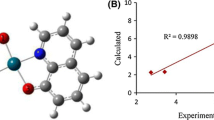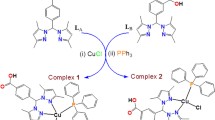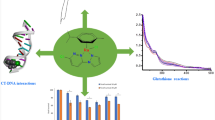Abstract
Imidazole ring is a known structure in many natural or synthetic drug molecules and its metal complexes can interact with DNA and do the cleavage. Hence, to study the influence of the structure and size of the ligand on biological behavior of metal complexes, two water-soluble Pd(II) complexes of phen and FIP ligands (where phen is 1,10-phenanthroline and FIP is 2-(Furan-2-yl)-1H–Imidazo[4,5-f][1, 10]phenanthroline) with the formula of [Pd(phen)(FIP)](NO3)2 and [Pd(FIP)2]Cl2, that were activated against chronic myelogenous leukemia cell line, K562, were selected. Also, the interaction of these anticancer Pd(II) complexes with highly polymerized calf thymus DNA was extensively studied by means of electronic absorption, fluorescence, and circular dichroism in Tris-buffer. The results showed that the binding was positive cooperation and [Pd(phen)(FIP)](NO3)2 (K f = 127 M-1 G = 1.2) exhibited higher binding constant and number of binding sites than [Pd(FIP)2]Cl2 (K f = 13 M-1 G = 1.03) upon binding to DNA. The fluorescence data indicates that quenching effect for [Pd(phen)(FIP)](NO3)2 (K SV = 58 mM−1) was higher than [Pd(FIP)2]Cl2 (K SV = 12 mM−1). Also, [Pd(FIP)2]Cl2 interacts with ethidium bromide-DNA, as non-competitive inhibition, and can bind to DNA via groove binding and [Pd(phen)(FIP)](NO3)2 can intercalate in DNA. These results were confirmed by circular dichroism spectra. Docking data revealed that longer complexes have higher interaction energy and bind to DNA via groove binding.

Two anticancer Pd(II) complexes of imidazole derivative have been synthesized and interacted with calf thymus DNA. Modes of binding have been studied by electronic absorption, fluorescence, and CD measurements. [Pd(FIP)2]Cl2 can bind to DNA via groove binding while intercalation mode of binding is observed for [Pd(phen)(FIP)](NO3)2.













Similar content being viewed by others
Abbreviations
- DNA:
-
Deoxyribonucleic acid
- EB:
-
Ethidium bromide
- FIP:
-
2-(Furan-2-yl)-1H-Imidazo[4,5-f][1, 10]phenanthroline
- phen:
-
1,10-Phenanthroline
- CD:
-
Circular dichroism
- RMSD:
-
Root-mean-square deviation
References
Jahromi, E. Z., Divsalar, A., Saboury, A. A., Khaleghizadeh, S., Mansouri-Torshizi, H., & Kostova, I. (2016). Palladium complexes: new candidates for anti-cancer drugs. Journal of the Iranian Chemical Society, 13, 967–989.
Shinkai, M., Suzuki, M., Iijima, S., & Kobayashi, T. (1995). Antibody conjugated magnetoliposomes for targeting cancer cells and their application in hyperthermia. Applied Biochemistry and Biotechnology, 21(2), 125–137.
Gomleksiz, M., Alkan, C., & Erdem, B. (2013). Synthesis, characterization and antibacterial activity of imidazole derivatives of 1, 10-phenanthroline and their Cu (II), Co (II) and Ni (II) complexes. South African Journal of Chemistry, 66, 107–112.
Kesharwani, R. K., Srivastava, V., Singh, P., Rizvi, S. I., Adeppa, K., & Misra, K. (2015). A novel approach for overcoming drug resistance in breast cancer chemotherapy by targeting new synthetic curcumin analogues against aldehyde dehydrogenase 1 (ALDH1A1) and glycogen synthase kinase-3 β (GSK-3β). Applied Biochemistry and Biotechnology, 176(7), 1996–2017.
Mansouri-Torshizi, H., I-Moghaddam, M., Divsalar, A., & Saboury, A. A. (2008). 2, 2′-Bipyridinebutyldithiocarbamatoplatinum (II) and palladium (II) complexes: synthesis, characterization, cytotoxicity, and rich DNA-binding studies. Bioorganic & Medicinal Chemistry, 16, 9616–9625.
Yassin, A. M., Elnouby, M., El-Deeb, N. M., & Hafez, E. E. (2016). Tungsten oxide nanoplates; the novelty in targeting metalloproteinase-7 gene in both cervix and colon cancer cells. Applied Biochemistry and Biotechnology, 1–15.
Jaszczyszyn, A., Gąsiorowski, K., Świątek, P., Malinka, W., Cieślik-Boczula, K., et al. (2012). Chemical structure of phenothiazines and their biological activity. Pharmacological Reports, 64, 16–23.
Mansouri-Torshizi, H., Saeidifar, M., Divsalar, A., & Saboury, A. A. (2010). Interaction studies between a 1, 10-phenanthroline adduct of palladium (II) dithiocarbamate anti-tumor complex and calf thymus DNA. A synthesis spectral and in-vitro study. Spectrochimica. Acta. Part A: Molecular and Biomolecular Spectroscopy, 77, 312–318.
Eslami Moghadam, M., Saidifar, M., Divsalar, A., Mansouri-Torshizi, H., Saboury, A. A., Farhangian, H., & Ghadamgahi, M. (2016). Rich spectroscopic and molecular dynamic studies on the interaction of cytotoxic Pt (II) and Pd (II) complexes of glycine derivatives with calf thymus DNA. Journal of Biomolecular Structure & Dynamics, 34, 206–222.
Eslami Moghadam M., Divsalar A., Abolhosseini Shahrnoy A., Saboury A.A. (2015) Synthesis, cytotoxicity assessment, and interaction and docking of novel palladium(II) complexes of imidazole derivatives with human serum albumin. Journal of Biomolecular Structure & Dynamics, 1–12.
Zheng, C. G., Ma, C. L., Yu, X. W., Qian, Q. L., Song, Y., Kong, J., & Xu, Y. (2011). Electronic effect of substituents on the DNA intercalation of ruthenium (II) Polypyridyl complexes. Chemistry & Biodiversity, 8, 1486–1496.
Ahmed, S. M., Pochaiah, B., & Harikishan, M. C. (2012). Synthesis and screening of 1H-substituted 2, 4, 5-triphenyl imidazole derivatives. Pharma Scient, 1, 8–11.
Refaat, H. M. (2010). Synthesis and anticancer activity of some novel 2-substituted benzimidazole derivatives. European Journal of Medicinal Chemistry, 45, 2949–2956.
Galaev, I. Y., Kumar, A., Agarwal, R., Gupta, M. N., & Mattiasson, B. (1997). Imidazole—a new ligand for metal affinity precipitation. Applied Biochemistry and Biotechnology, 68(1–2), 121–133.
Shalini, K., Sharma, P. K., & Kumar, N. (2010). Imidazole and its biological activities: a review. Der Chemica Sinica., 1, 36–47.
Shahabadi, N., & Nemati, L. (2014). Multispectroscopic studies on the interaction of a platinum (II) complex containing l-histidine and 1, 10-phenanthroline ligands with bovine serum albumin. Applied Biochemistry and Biotechnology, 172(6), 2800–2814.
Eslami Moghadam, M., Saidifar, M., Rostami-Charati, F., Ajloo, D., & Ghadamgahi, M. (2014). Molecular dynamic simulation and spectroscopic investigation of some cytotoxic palladium (II) complexes interaction with human serum albumin. Combinatorial Chemistry & High Throughput Screening, 17, 781–789.
Islami-Moghaddam, M., Mansouri-Torshizi, H., Divsalar, A., & Saboury, A. A. (2009). Synthesis, characterization, cytotoxic and DNA binding studies of diimine platinum (II) and palladium (II) complexes of short hydrocarbon chain ethyldithiocarbamate ligand. Journal of the Iranian Chemical Society, 6, 552–569.
Mansouri-Torshizi, H., Eslami-Moghadam, M., Divsalar, A., & Saboury, A. A. (2011). DNA-binding studies of some potential antitumor 2, 2′–bipyridine Pt (II)/Pd (II) complexes of piperidinedithiocarbamate. Their synthesis, spectroscopy and cytotoxicity. Acta Chimica Slovenica, 58, 811–822.
Coban, B., & Yildiz, U. (2014). DNA-binding studies and antitumor evaluation of novel water soluble organic pip and hpip analogs. Applied Biochemistry and Biotechnology, 172(1), 248–262.
Li, Z. S., Yang, H. X., Zhang, A. G., Luo, H., & Wang, K. Z. (2011). pH effects on optical and DNA binding properties of a thiophene-containing ruthenium (II) complex. Inorganica Chimica Acta, 370, 132–140.
Divsalar, A., Saboury, A. A., Yousefi, R., Moosavi-Movahedi, A. A., & Mansoori-Torshizi, H. (2007). Spectroscopic and cytotoxic studies of the novel designed palladium (II) complexes: β-Lactoglobulin and K562 as the targets. International Journal of Biological Macromolecules, 40, 381–386.
Srishailam, A., Gabra, N. M., Kumar, Y. P., Reddy, K. L., Devi, C. S., et al. (2014). Synthesis, characterization; DNA binding and antitumor activity of ruthenium (II) polypyridyl complexes. Journal of Photochemistry and Photobiology, 281, 3945–3554.
Patel, M. N., Patel, C. R., & Joshi, H. N. (2013). Metal-based biologically active compounds: synthesis, characterization, DNA interaction, antibacterial, cytotoxic and SOD mimic activities. Applied Biochemistry and Biotechnology, 169(4), 1329–1345.
Icsel, C., Yilmaz, V. T., Golcu, A., Ulukaya, E., & Buyukgungor, O. (2013). Synthesis, crystal structures, DNA binding and cytotoxicity of two novel platinum (II) complexes containing 2-(hydroxymethyl) pyridine and pyridine-2-carboxylate ligands. Bioorganic & Medicinal Chemistry Letters, 23, 2117–2122.
Saboury, A. A., & Moosavi Movahedi, A. A. (1994). Evaluation of the Hill coefficient from Scatchard and Klotz plots. Biochemical Education, 22, 48–49.
Stanyon, H. F., Cong, X., Chen, Y., Shahidullah, N., Rossetti, G., et al. (2014). Developing predictive rules for coordination geometry from visible circular dichroism of copper (II) and nickel (II) ions in histidine and amide main-chain complexes. The FEBS Journal, 281, 3945–3954.
White, S. H., & Wimley, W. C. (1999). Membrane protein folding and stability: physical principles. Annual Review of Biophysics, 28, 319–365.
Saboury, A. A. (2009). Enzyme inhibition and activation: a general theory. Journal of the Iranian Chemical Society, 6, 219–229.
Divsalar, A., Saboury, A. A., Mansoori-Torshizi, H., Moghaddam, M. I., Ahmad, F., & Hakimelahi, G. H. (2009). Comparative studies on the interaction between bovine β-lacto-globulin type a and B and a new designed Pd (II) complex with anti-tumor activity at different temperatures. Journal of Biomolecular Structure & Dynamics, 26, 587–597.
Grant, M. A., Baron, R. M., Macias, A. A., Layne, M. D., Perrella, M. A., & Rigby, A. C. (2009). Netropsin improves survival from endotoxaemia by disrupting HMGA1 binding to the NOS2 promoter. The Biochemical Journal, 418, 103–112.
Saboury, A. A. (2006). A review on the ligand binding studies by isothermal titration calorimetry. Journal of the Iranian Chemical Society, 3, 1–21.
Mital, R., Jain, N., & Srivastava, T. S. (1989). Synthesis, characterization and cytotoxic studies of diamine and diimine palladium (II) complexes of diethyldithiocarbamate and binding of these and analogous platinum (II) complexes with DNA. Inorganica Chimica Acta, 166, 135–140.
Wang, C., Wu, Q. H., Wang, Z., & ZHAO, J. (2006). Study of the interaction of carbamazepine with bovine serum albumin by fluorescence quenching method. Analytical Sciences, 22, 435–438.
Crouse, H. F., Petrunak, E. M., Donovan, A. M., Merkle, A. C., Swartz, B. L., & Basu, S. (2011). Static and dynamic quenching of tryptophan fluorescence in various proteins by a chromium (III) complex. Spectroscopy Letters, 44, 369–374.
Xiao, J. B., Chen, J. W., Cao, H., Ren, F. L., Yang, C. S., Chen, Y., & Xu, M. (2007). Study of the interaction between baicalin and bovine serum albumin by multi-spectroscopic method. Journal of Photochemistry and Photobiology A: Chemistry, 191, 222–227.
Arounaguiri, S., & Maiya, B. G. (1999). “Electro-photo switch” and “molecular light switch” devices based on ruthenium (II) complexes of modified dipyridophenazine ligands: modulation of the photochemical function through ligand design. Inorganic Chemistry, 38, 842–843.
Froehlich, E., Mandeville, J. S., Jennings, C. J., Sedaghat-Herati, R., & Tajmir-Riahi, H. A. (2009). Dendrimers bind human serum albumin. The Journal of Physical Chemistry. B, 113, 6986–6993.
Ghalandari, B., Divsalar, A., Eslami-Moghadam, M., Saboury, A. A., Haertlé, T., Amanlou, M., & Parivar, K. (2015). Probing of the interaction between β-Lactoglobulin and the anticancer drug oxaliplatin. Applied Biochemistry and Biotechnology, 175, 974–987.
Holm, A. I. S., Nielsen, L. M., Hoffmann, S. V., & Nielsen, S. B. (2010). Vacuum-ultraviolet circular dichroism spectroscopy of DNA: a valuable tool to elucidate topology and electronic coupling in DNA. Physical Chemistry Chemical Physics, 12, 9581–9596.
Kypr, J., Kejnovská, I., Renčiuk, D., & Vorlíčková, M. (2009). Circular dichroism and conformational polymorphism of DNA. Nucleic Acids Research, 37, 1713–1725.
Song, X. Q., Wang, Y. W., Zheng, J. R., Liu, W. S., & Tan, M. Y. (2007). Synthesis and spectroscopic properties of lanthanide nitrate complexes with a new amide-based quinoxaline-2, 3-dione ligand. Spectrochim. Acta. Mol., 68, 701–704.
Acknowledgements
The authors gratefully acknowledge the financial support of the Chemistry & Chemical Engineering Research Center of Iran.
Author information
Authors and Affiliations
Corresponding author
Rights and permissions
About this article
Cite this article
Heydari, M., Moghadam, M.E., Tarlani, A. et al. DNA as a Target for Anticancer Phen-Imidazole Pd(II) Complexes. Appl Biochem Biotechnol 182, 110–127 (2017). https://doi.org/10.1007/s12010-016-2314-2
Received:
Accepted:
Published:
Issue Date:
DOI: https://doi.org/10.1007/s12010-016-2314-2




